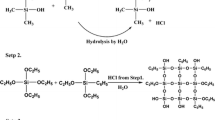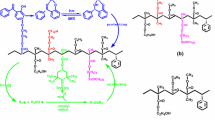Abstract
Silicone resin is a coating material with good performance. The improvement of its thermal stability and hydrophobicity has always been the pursuit of researchers. In this paper, a series of novel UV-curable silicone resins containing perfluorocyclobutyl (PFCB) groups were prepared by co-hydrolytic polycondensation. The structures of the resin precursor MDT-SH were characterized by FT-IR and 1H NMR. The heat resistance of them was studied by TGA and DSC, and results show that the PFCB groups can significantly improve the high temperature resistance of the resins. Contact angle tests showed that hydrophobicity of them was also enhanced by the PFCB groups.
Similar content being viewed by others
Data Availability
Not applicable.
References
Robeyns C, Picard L, Ganachaud F (2018) Synthesis, characterization and modification of silicone resins: An “Augmented Review.” Prog Org Coat 125:287–315. https://doi.org/10.1016/j.porgcoat.2018.03.025
Narisawa M (2010) Silicone Resin Applications for Ceramic Precursors and Composites. Mater 3:3518–3536. https://doi.org/10.3390/ma3063518
Zhang BJ, Zhuo DX, Gu AJ, Liang GZ, Hu JT, Yuan L (2012) Preparation and properties of addition curable silicone resins with excellent dielectric properties and thermal resistance. Polym Eng Sci 52:259–267. https://doi.org/10.1002/pen.22077
Nan G, Zhou D, Qin Y (2014) Synthesis and preparation of silicone resins used for LED packaging. New Chem Mater 42:135–137
Zuo YJ, Gou ZM, Zhang J, Feng SY (2016) Color-Transformable Silicone Elastomers Prepared by Thiol-Ene Reaction with Potential Application in UV-LEDs. Macromol Rapid Commun 37:597–604. https://doi.org/10.1002/marc.201500671
Pan ZQ, Zhu SL, Huang BS, Kang YZ, Zhu LQ (2019) Synthesis of High-Refractive-Index Epoxy-Modified Vinyl Methyl Phenyl Silicone Resins for Encapsulation of LEDs. J Electron Mater 48:2865–2875. https://doi.org/10.1007/s11664-019-07015-x
Mosley DW, Khanarian G, Conner DM, Thorsen DL, Zhang TL, Wills M (2014) High Refractive Index Thermally Stable Phenoxyphenyl and Phenylthiophenyl Silicones for Light-Emitting Diode Applications. J Appl Polym Sci 131:10. https://doi.org/10.1002/app.39824
Wu TY, Lai XJ, Liu FJ, Li HQ, Zeng XR (2018) Efficiently enhancing the tracking and erosion resistance of silicone rubber by the synergism of fluorine-containing polyphenylsilsesquioxane and ureido-containing MQ silicone resin. Appl Surf Sci 459:483–491. https://doi.org/10.1016/j.apsusc.2018.08.021
Decker C (2005) New developments in UV radiation curing of protective coatings. Surf Coat Int Pt B-Coat Trans 88:9–17. https://doi.org/10.1007/bf02699702
Zheng XQ, Pang AM, Wang Y, Wang W, Bai YP (2020) Fabrication of UV-curable fluorosilicone coatings with impressive hydrophobicity and solvent resistance. Prog Org Coat 144:8. https://doi.org/10.1016/j.porgcoat.2020.105633
Liang ZH, Cheng YT, Hsu W, Lee YW (2004) A low temperature wafer-level hermetic MEMS package using UV curable adhesive, 2004 Proceedings. 54th Electronic Components and Technology Conference (IEEE Cat. No.04CH37546), vol 2, Las Vegas, NV, USA, pp 1486–1491. https://doi.org/10.1109/ECTC.2004.1320311
Yang XF, Chen Q, Bao HY, Liu JL, Wu YF, Lai GQ (2018) Preparation and performance of ultraviolet curable silicone resins used for ultraviolet cured coating and ultraviolet-assisted 3D printing materials. OSA Continuum 1:542–552. https://doi.org/10.1364/osac.1.000542
Palaganas J, de Leon A, Mangadlao J, Palaganas N, Mael A, Lee YJ, Lai HY, Advincula R (2017) Facile Preparation of Photocurable Siloxane Composite for 3D Printing. Macromol Mater Eng 302:9. https://doi.org/10.1002/mame.201600477
Yang XF, Cheng F, Fan YX, Song Y, He N, Lai GQ, Gong ZS, Shen JB (2022) Highly transparent acrylate epoxidized soybean oil based UV-curable silicone-modified coatings with good thermal stability and flame retardancy. Prog Org Coat 165:8. https://doi.org/10.1016/j.porgcoat.2022.106769
Wang B, Qian T, Zhang QH, Zhan XL, Chen FQ (2016) Heat resistance and surface properties of polyester resin modified with fluorosilicone. Surf Coat Technol 304:31–39. https://doi.org/10.1016/j.surfcoat.2016.06.075
Junyan L, Ling H, Weidong L, Hongjie L (2009) Synthesis and analysis of properties of a new core-shell silicon-containing fluoroacrylate latex. Polym Int 58:1283–1290. https://doi.org/10.1002/pi.2660
Zhang KQ, Li XH, Zhao YH, Zhu KY, Li YC, Tao C, Yuan XY (2016) UV-curable POSS-fluorinated methacrylate diblock copolymers for icephobic coatings. Prog Org Coat 93:87–96. https://doi.org/10.1016/j.porgcoat.2016.01.005
Ma CY, Bai JW, Zhou ZL, Gao B, Deng JG (2022) Trifluoromethanesulfonic acid-assisted one-pot catalytic synthesis of phenyl silicone resins. Polym Bull 79:985–1000. https://doi.org/10.1007/s00289-021-03542-y
Liu YT, Zhu D, Sun JW, Li J, Wu YM, Gao CH (2019) Synthesis and characterization of a novel fluorosilicone resin based on trifluoropropylalkoxylsilane. Mater Chem Phys 224:40–46. https://doi.org/10.1016/j.matchemphys.2018.11.077
Rizzo J, Harris FW (2000) Synthesis and thermal properties of fluorosilicones containing perfluorocyclobutane rings. Polymer 41:5125–5136. https://doi.org/10.1016/s0032-3861(99)00579-0
Yuan Y, Diao S, Zhao CD, Wang MY, Wang X, Wang QJ (2020) Synthesis of polysiloxanes containing trifluoroethylene aryl ether groups: The effect of promoters. Polym Adv Technol 31:1127–1138. https://doi.org/10.1002/pat.4847
Iacono ST, Budy SM, Mabry JM, Smith DW (2007) Synthesis, characterization, and properties of chain terminated polyhedral oligomeric silsesquioxane-functionalized perfluorocyclobutyl aryl ether copolymers. Polymer 48:4637–4645. https://doi.org/10.1016/j.polymer.2007.06.022
Hong JJ, Bi LP, Li SN, Jia GY, Zhu YQ, Li GH, Huang ZQ (2016) Design and synthesis of reactive polymers containing perfluorocyclobutyl (PFCB) and hydroxyl moieties for post-functionalization of PFCB aryl ether polymers. Polymer 93:37–43. https://doi.org/10.1016/j.polymer.2016.04.012
Zhou JF, Tao YQ, Chen XY, Chen XR, Fang LX, Wang YQ, Sun J, Fang Q (2019) Perfluorocyclobutyl-based polymers for functional materials. Mat Chem Front 3:1280–1301. https://doi.org/10.1039/c9qm00001a
Huang R, Yao JS, Mu QH, Peng D, Zhao H, Yang ZZ (2020) Study on the Synthesis and Thermal Stability of Silicone Resin Containing Trifluorovinyl Ether Groups. Polymers 12:12. https://doi.org/10.3390/polym12102284
Liu Z, Lin Z, Xiang H, Rong M, Zhang M (2020) Preparation and Properties of UV-curable Silicone Resin for LED Package. China Plastics 34:68–76
Wang YQ, Wang JJ, Jin KK, Sun J, Fang Q (2016) A new glass-forming molecule having a fluorene skeleton: synthesis and conversion to the polymer with a low dielectric constant, high hydrophobicity and thermostability. Polym Chem 7:5925–5929. https://doi.org/10.1039/c6py01212d
Xu YH, Xiong XQ, Cai L, Tang ZK, Ye ZJ (2012) Thiol-Ene Click Chemistry Prog Chem 24:385–394
Wu J, Ling L, Ma G, Wan B (2013) The Application of Thiol-Ene Click Reaction in UV Curing Process. Polymer Mater Sci Eng 29:169–174
Krizhanovskiy I, Temnikov M, Kononevich Y, Anisimov A, Drozdov F, Muzafarov A (2022) The Use of the Thiol-Ene Addition Click Reaction in the Chemistry of Organosilicon Compounds: An Alternative or a Supplement to the Classical Hydrosilylation? Polymers 14:35. https://doi.org/10.3390/polym14153079
Lomakin SM, Koverzanova EV, Shilkina NG, Usachev SV, Zaikov GE (2003) Thermal degradation of polystyrene-polydimethylsiloxane blends. Russ J Appl Chem 76:472–482. https://doi.org/10.1023/a:1025677423514
Funding
The authors declare that no funds, grants, or other support were received during the preparation of this manuscript.
Author information
Authors and Affiliations
Contributions
Conceptualization, Xinglong Wu and Bo Ai; methodology, Xinglong Wu and Xiaolei Li.; validation, Jiaqi Zhong, Xiaoli Xu and Baoyun Xu; formal analysis, Xinglong Wu; investigation, Xiaolei Li, Jiaqi Zhong and Baoyun Xu; data curation, Xinglong Wu and Xiaolei Li; writing—original draft preparation, Xinglong Wu; writing—review and editing, Bo Ai. All authors have read and agreed to the published version of the manuscript.
Corresponding author
Ethics declarations
Ethics Approval
The authors declare that they have no known competing financial interest or personal relationships that could have appeared to influence the work reported in this paper.
Consent to Participate
All authors voluntarily agree to participate in this review paper.
Consent for Publication
All authors give the permission to the Journal to publish this review paper.
Competing Interests
The authors declare no competing interests.
Additional information
Publisher's Note
Springer Nature remains neutral with regard to jurisdictional claims in published maps and institutional affiliations.
Rights and permissions
Springer Nature or its licensor (e.g. a society or other partner) holds exclusive rights to this article under a publishing agreement with the author(s) or other rightsholder(s); author self-archiving of the accepted manuscript version of this article is solely governed by the terms of such publishing agreement and applicable law.
About this article
Cite this article
Wu, X., Li, X., Zhong, J. et al. Preparation and Characterization of UV-curable Silicone Resin Containing Perfluorocyclobutyl Aryl Ether Groups. Silicon 15, 5691–5701 (2023). https://doi.org/10.1007/s12633-023-02431-5
Received:
Accepted:
Published:
Issue Date:
DOI: https://doi.org/10.1007/s12633-023-02431-5




